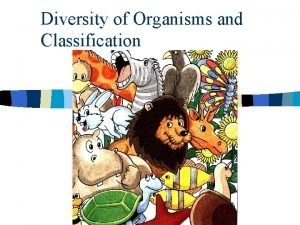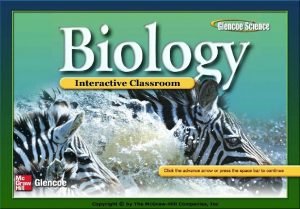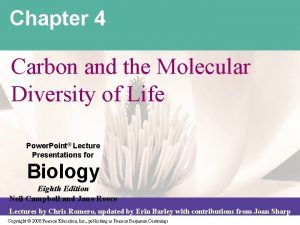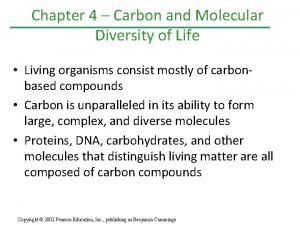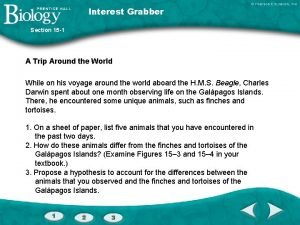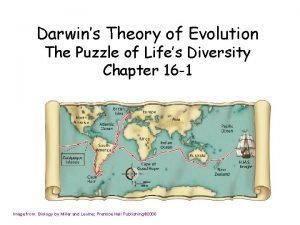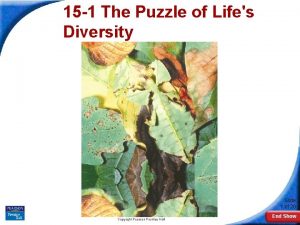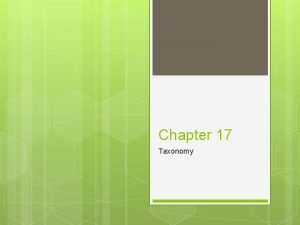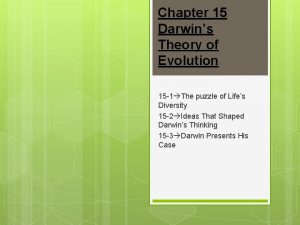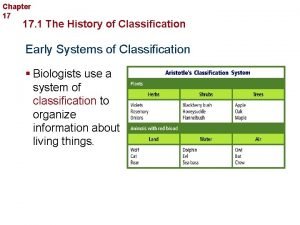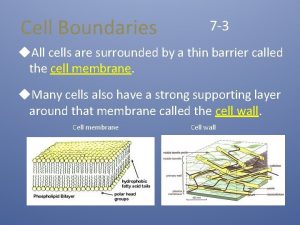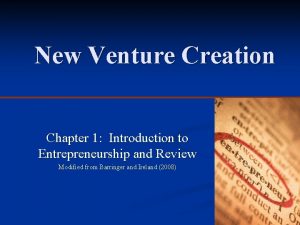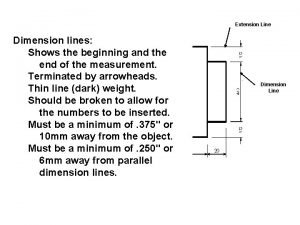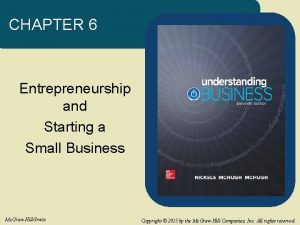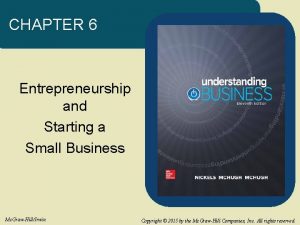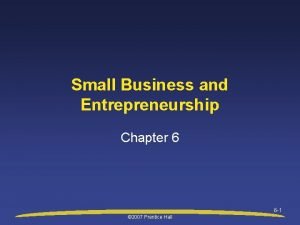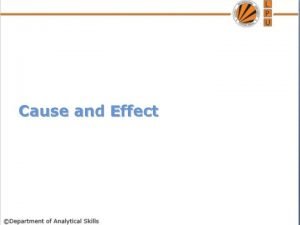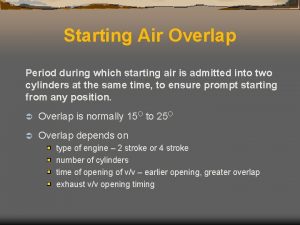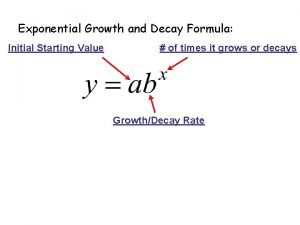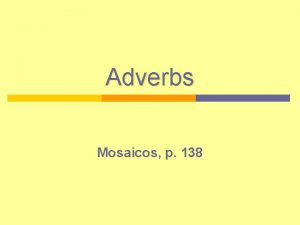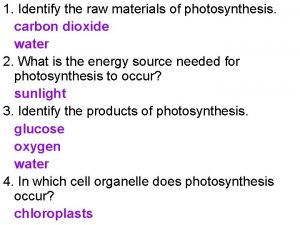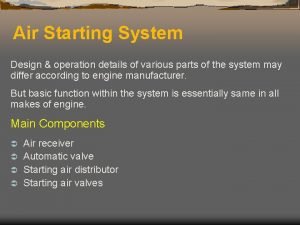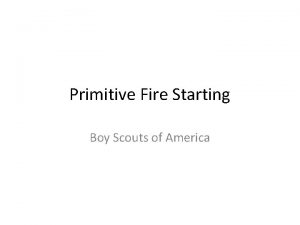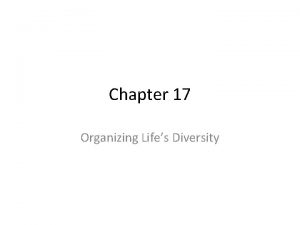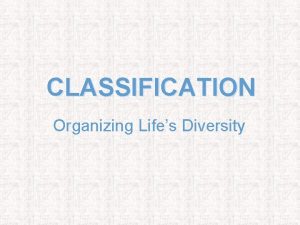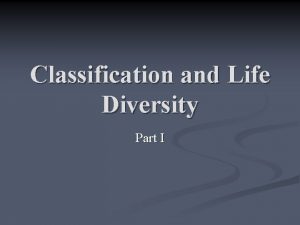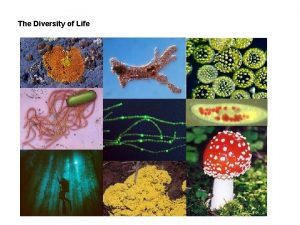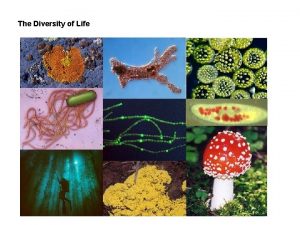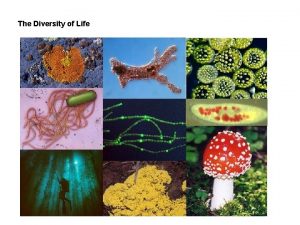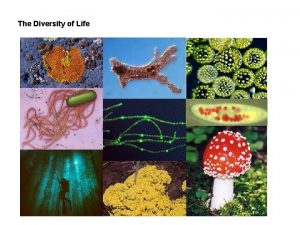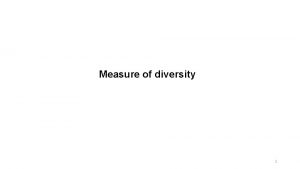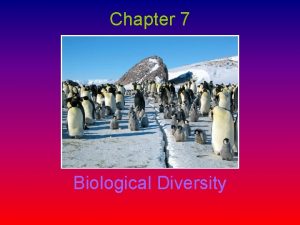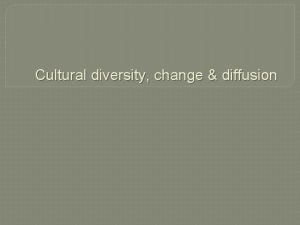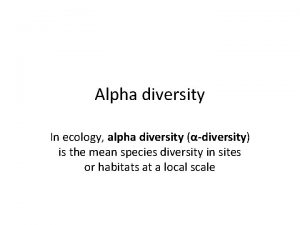Today More classification and diversity of life starting




























































































- Slides: 92

Today: • More classification and diversity of life –starting animals!

DOMAINS KINGDOMS Protista Eukarya Fungi Plantae Animalia Bacteria Archaea Eubacteria Archaebacteria

Naming organisms • Domain • Kingdom • Phylum • Class • Order • Family • Genus • Species

ANIMALS What are their shared characteristics?

DOMAIN EUKARYA Kingdom Animalia - Multicellular Made of animal cells (no cell walls) Heterotrophs (eat food) Use Oxygen to make ATP (energy) - Genes have introns

Which of the following is true about all animals? 1. They eat food 2. They make their own food 3. They are warm blooded 4. They have fur

Naming organisms • Domain • Kingdom • Phylum • Class • Order • Family • Genus • Species

Phyla in Kingdom Animalia NOTE: There almost 100 total phyla for the 6 kingdoms! There are ~38 animal phyla, but most species are found in the top 9 phyla


Phylum Porifera • Sponges • 5000 species worldwide! • Asexual reproduction


Cnidaria = stinging animals jellyfish, coral, and anemones

Cnidaria • Over 10, 000 species • No brain, have a simple nervous system • Have ONE opening that is the mouth and anus (sac-like digestive system) • Have tentacles and stinging cells (nematocyst)

Phylum Cnidaria Class Anthozoa • Coral and sea anemone • Can asexually reproduce by budding or fragmentation

Phylum Cnidaria Class Scyphozoa • JELLYFISH • Made of 95 -98% water

Sexual reproduction = sperm and eggs Asexual reproduction

Phylum Cnidaria Class Cubozoa • • • BOX JELLIES Found in Australia and the Philippines Many species have venom that can kill! Has killed over 5000 people One of the most toxic venoms on the planet!


Which animal phylum contains sponges? A. B. C. D. Mollusca Porifera Cnidaria Annelida

Platyhelminthes=Flatworms • First to have organ systems (very simple) • Examples: planaria & tape worms • Planaria can do asexual reproduction (fragmentation)

Nematoda= round worms • Common roundworms, hookworms, and trichina • Around 12, 000 species

Annelida= ringed worms • Earthworms, other worms, leeches • Over 12, 000 species

Annelida • Bodies are segmented (divided into sections) • First phylum with a developed digestive system- mouth, “stomach”, and anus

Phylum Annelida Class Polychaeta = marine worms

Which animal phylum is the first to have a complete digestive system? A. B. C. D. E. Mollusca Porifera Cnidaria Annelida Arthropoda

Mollusca Clams, mussels, snails, slugs, squid and octopus 112, 000 species of mollusks!

Phylum Mollusca Class Bivalvia • Oysters and clams

Phylum Mollusca Class Gastropoda

Chiton

Limpet

Phylum Mollusca Class Cephalopoda • Architeuthis dux (giant squid) • Mesonychoteuthis hamiltoni (colossal)

• Octopus vulgaris (common octopus) • http: //www. youtube. com/watch? v=Pm. DTtk. Zl. Mw. M • http: //www. wimp. com/octopusmimic/ • http: //video. google. com/videoplay? docid=4007016107763801953&hl=en

Do all mollusks have shells? A. Yes B. No

Arthropoda = Crustaceans and insects

Arthropoda • Arthropoda– insects, spiders, crustaceans • Means jointed legs, have exoskeletons • Largest animal phylum, over 80% of all animals on planet are arthropods, over 1 million species • Some insects can reproduce without a male!

Arthropoda • Subphyla: Spiders, Millipedes and centipedes, Insects, and Crustaceans (shrimp, crabs, lobster, barnacles)

Echinodermataspiny skinned animals Sea star Sea cucumber Sea urchin

Echinoderms • Have tube feet (lots of suction cups to hold onto rocks, etc. ) • All live in the ocean • About 6000 species • Regeneration- asexual reproduction

Which is the largest animal phylum? A. B. C. D. E. Mollusca Porifera Cnidaria Annelida Arthropoda

Do all animals reproduce sexually? A. Yes B. No

Chordata (vertebrates) = animals with backbones

Naming organisms • Domain • Kingdom • Phylum • Class • Order • Family • Genus • Species

Classes in Domain Eukarya, Kingdom Animalia, Phylum Chordata • Class Amphibia (amphibians) • Class Reptilia (reptiles) • Class Aves (birds) • Class Osteichthyes (bony fish) • Class Chondrichthyes (cartilaginous fish– sharks and rays) • Class Mammalia (mammals)

Which group of living things contains groups you learned in elementary school (reptiles, mammals, etc. )? A. B. C. D. Domain Kingdom Phylum Class

Amphibians (means two lives) • Skin must stay moist (breathe through it!) • Lay eggs in water • Babies develop in water and then later move to land

Reptiles • • Covered with scales Lay eggs on land Breathe with lungs Ectothermic (cold-blooded)- their internal body temp. depends on the outside temp!

Reptiles

Marine Iguana– only in the Galapagos!

Sea Turtles • Seven species worldwide – Loggerheads – Leatherbacks – Greens – Olive Ridley – Kemp’s Ridley – Hawksbill – Flatback

Leatherbacks Dermochelys coriacea

Greens Chelonia mydas

Hawksbill turtles Eretmochelys imbricata

Which phylum contains reptiles? A. B. C. D. E. Mollusca Reptilia Cnidaria Chordata Arthropoda

Class Aves = Birds • Covered with feathers • Lay hard eggs on land • Breathe with lungs

Class Osteichthyes = Bony fish • Most covered with scales • Breathe through gills • Have a hard internal skeleton





Ocean Sunfish (Mola mola) • Largest bony fish in the world– up to 11 ft and 5000 lbs • Eats jellyfish and other gelatinous zooplankton and sometimes very small fish • Can lay over 300 million eggs at a time (more than any known vertebrate)



Clown fish

Seahorse • Famous for being the only males that carry the babies


Which of the following is true about all osteichthyes? A. They have cartilaginous skeletons. B. They have teeth. C. They lay eggs. D. They have bony skeletons.

Class Chondrichthyes = Cartilaginous fish • Not normal scales • Breathe through gills • Have an internal skeleton made of cartilage

“Great” White Shark Carcharodon carcharias • White sharks have existed for 11 million years (immediate ancestors were around 60 million years ago!) • Up to 30 feet long, 2000 pounds, 3000 teeth

Whale Shark • Rhincodon typus • Largest living fish species – Biggest recorded was 42 feet (47, 000 lbs!), but some people claim to see up to 60 foot ones!


Hammerhead Shark Sphyrna zygaena Sphyrna lewini (scalloped hammerhead) - These ladies breed in Hawaiian waters

Tiger Shark • Galeocerdo cuvier • Grow to be 10 -14 feet long

Manta Ray or Giant Manta

Manta Ray or Giant Manta • Manta birostris • Largest of the ray species– up to 25 feet long and 3000 pounds!

Sting Ray

Which of the following is true about all chondrichthyes? A. B. C. D. They have teeth. They lay eggs. They breathe through gills. They have bony skeletons.

Mammals • • • 5000 species with 26 orders Breathe through lungs Have hair of some kind Almost all have live birth All produce milk for their young

Naming organisms • Domain • Kingdom • Phylum • Class • Order • Family • Genus • Species

Orders in Class Mammalia • Order Rodentia (rodents) • Order Carnivora (bears, lions, wolves) • Order Cetacea (whales and dolphins) • Order Primates (apes, gorillas, humans)

In what class are humans? A. B. C. D. Biology No class Primates Mammals

In what order are humans? A. B. C. D. Primates Mammals Hominidae None of the above

MAMMALS - Rodentia Rodent teeth

MAMMALS - Carnivora

MAMMALS - Cetacea

Orca Orsinus orca -Often called “killer whales” because of their violent eating habits -Largest dolphin MALE FEMALE

Bottlenose dolphins Tursiops truncatus -Average length 6 -12 feet -Weigh up to 1400 lbs (usually smaller) -Live all over the world (except the poles)

Other dolphins Atlantic whitesided dolphin Striped dolphin Risso’s Pantropical dolphin

Toothed “true” Whales Order Cetacea, Suborder Odontoceti Sperm whales • Largest toothed animal alive (60 feet) • Moby Dick •

MAMMALS - Primates Bonobo Black Lemur Rhesus Monkey Orangutan Gorilla

Primates • 233 living species • Share many characteristics in the skull, limbs, and teeth

Family Hominidae • Includes humans, gorillas, chimpanzees, and orangutans • All have: – opposable thumbs (only humans DON’T have opposable big toes!) – flattened nails and are ominivorous – no tail – large braincase – can walk upright or semi-upright • Humans are Homo sapiens

In what genus are humans? A. B. C. D. E. Primates Mammals Hominidae Homo sapiens
 Lirik lagu more more more we praise you
Lirik lagu more more more we praise you More more more i want more more more more we praise you
More more more i want more more more more we praise you Why is genetic diversity important
Why is genetic diversity important Ecosystem jigsaw activity
Ecosystem jigsaw activity For todays meeting
For todays meeting Today's classes
Today's classes Meeting objective
Meeting objective Characteristic of fingerprint
Characteristic of fingerprint Today's lesson or today lesson
Today's lesson or today lesson Example of repitition
Example of repitition Is a leaf unicellular or multicellular
Is a leaf unicellular or multicellular Blended family
Blended family A dollar today is worth more than a dollar tomorrow
A dollar today is worth more than a dollar tomorrow A dollar today is worth more tomorrow
A dollar today is worth more tomorrow Human history becomes more and more a race
Human history becomes more and more a race Diversity and interdependence of life
Diversity and interdependence of life Chapter 17 section 1 the history of classification
Chapter 17 section 1 the history of classification Bio means life and diversity means
Bio means life and diversity means Carbon and the molecular diversity of life
Carbon and the molecular diversity of life Chapter 4 carbon and the molecular diversity of life
Chapter 4 carbon and the molecular diversity of life Paragraph about life in the past and today 3am
Paragraph about life in the past and today 3am The more you take the more you leave behind
The more you take the more you leave behind The more you study the more you learn
The more you study the more you learn Aspire not to have more but to be more
Aspire not to have more but to be more More inertia
More inertia Knowing more remembering more
Knowing more remembering more The more i give to thee the more i have
The more i give to thee the more i have More choices more chances
More choices more chances Section 15-1 the puzzle of life's diversity answer key
Section 15-1 the puzzle of life's diversity answer key Section 15-1 the puzzle of life's diversity answer key
Section 15-1 the puzzle of life's diversity answer key The puzzle of life's diversity
The puzzle of life's diversity Organizing life's diversity
Organizing life's diversity Section 15-1 the puzzle of life's diversity answer key
Section 15-1 the puzzle of life's diversity answer key Chapter 17 organizing life's diversity
Chapter 17 organizing life's diversity Section 7-4 the diversity of cellular life
Section 7-4 the diversity of cellular life Section 7-4 the diversity of cellular life
Section 7-4 the diversity of cellular life Chapter 4 performing basic maneuvers page 14
Chapter 4 performing basic maneuvers page 14 Creating and starting the venture
Creating and starting the venture Alphabet of lines
Alphabet of lines Fundamental starting position
Fundamental starting position Chapter 6 entrepreneurship and starting a small business
Chapter 6 entrepreneurship and starting a small business Chapter 6 entrepreneurship and starting a small business
Chapter 6 entrepreneurship and starting a small business Entrepreneurship chapter 6
Entrepreneurship chapter 6 Fundamental standing position
Fundamental standing position Entrepreneurship chapter 6
Entrepreneurship chapter 6 The major cause
The major cause Happy friday wife
Happy friday wife Family life today
Family life today Family life today
Family life today Worry
Worry Thinking of starting a business
Thinking of starting a business Character traits starting with n
Character traits starting with n Qualities starting with n
Qualities starting with n Pony motor starting method diagram
Pony motor starting method diagram Starting air overlap
Starting air overlap Presentation starting speech
Presentation starting speech Starting materials for cellular respiration
Starting materials for cellular respiration Tag essay example
Tag essay example How to start a introduction
How to start a introduction Formal letterhead
Formal letterhead Contrast and concession connectors
Contrast and concession connectors Exponential growth examples
Exponential growth examples Sturdt
Sturdt Chapter 30 engine starting systems
Chapter 30 engine starting systems Starting materials for cellular respiration
Starting materials for cellular respiration Heun method
Heun method Small busness
Small busness Checking accounts 101
Checking accounts 101 Air starting system working principle
Air starting system working principle Words of frequency
Words of frequency Adverb vs adjective examples
Adverb vs adjective examples Air starting system in marine diesel engine
Air starting system in marine diesel engine Starting materials for cellular respiration
Starting materials for cellular respiration The law of conservation states
The law of conservation states The starting point in a presentation
The starting point in a presentation Em waves song lyrics
Em waves song lyrics Holocaust acrostic poem examples
Holocaust acrostic poem examples Project plan for resort
Project plan for resort Nyx family tree
Nyx family tree Conservation of mechanical energy
Conservation of mechanical energy Hexagon agility test counterclockwise time
Hexagon agility test counterclockwise time The starting substances in a chemical reaction.
The starting substances in a chemical reaction. Principle of operation of synchronous motor
Principle of operation of synchronous motor Pilot valve in air starting system
Pilot valve in air starting system _____ is difficulty in starting a urinary stream.
_____ is difficulty in starting a urinary stream. Components of starting system
Components of starting system A small child slides down the four frictionless slides
A small child slides down the four frictionless slides Primitive fire starting
Primitive fire starting Ordering fractions and decimals
Ordering fractions and decimals Lines of latitude run from
Lines of latitude run from Spacex starting salary
Spacex starting salary Once upon a time nadine gordimer
Once upon a time nadine gordimer Chapter 1 starting a proprietorship
Chapter 1 starting a proprietorship










